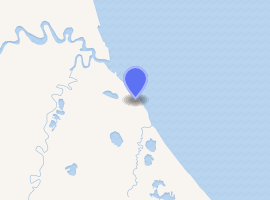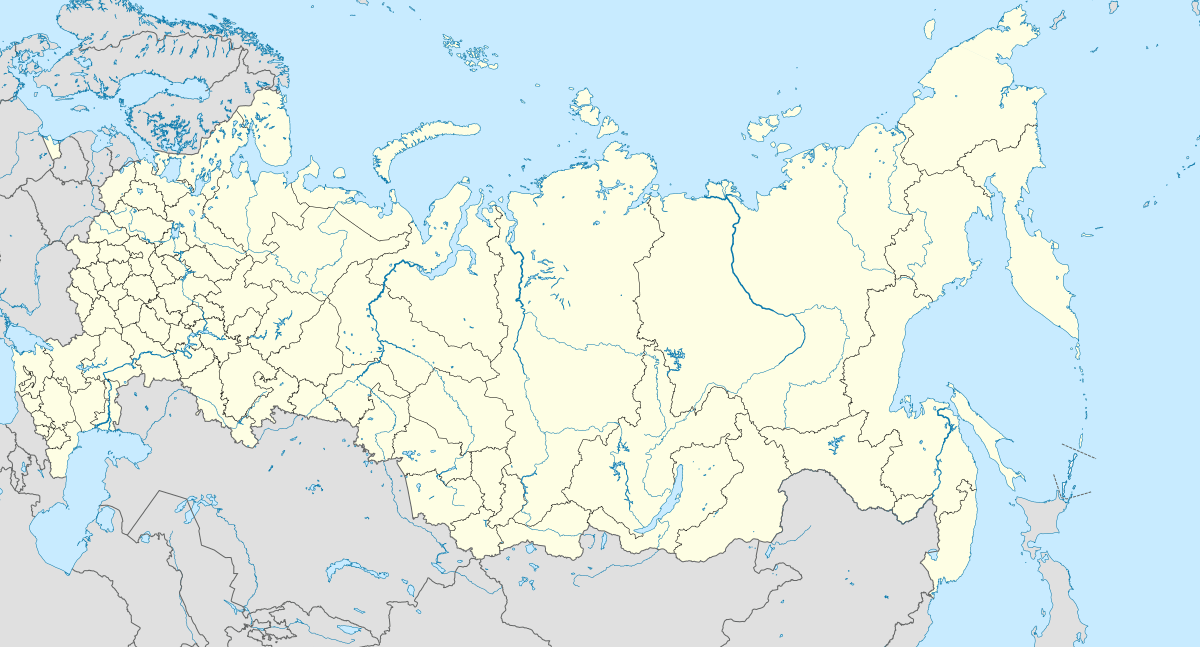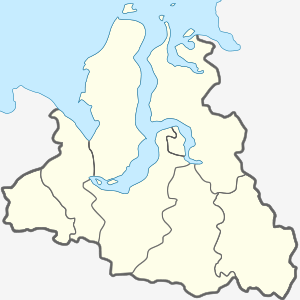Sabetta
Sabetta (Russian: Сабетта) is the location of a port and LNG plant—Yamal LNG—on the Yamal Peninsula, in the north of Russia.
Sabetta Сабетта | |
|---|---|
.jpg) Russian icebreaker Tor in the ice-covered port of Sabetta | |
Location of Sabetta 
| |
 Sabetta Location of Sabetta  Sabetta Sabetta (Yamalo-Nenets Autonomous Okrug) | |
| Coordinates: 71.2733°N 72.0725°E | |
| Country | Russia |
| Federal subject | Yamalo-Nenets Autonomous Okrug |
Location
The site chosen for the port is on the western shore of the Ob estuary, on the Yamal peninsula. It is close to, and will serve, the Yuzhno-Tambeyskoye gas field.[1]
Project
The port is a joint venture between Novatek—a large producer of natural gas—and the Russian government. The groundbreaking ceremony was held in July 2012,[2] but construction of the port itself was scheduled to begin in the summer of 2013.[3] The project includes a large LNG plant, capable of producing 16.5 million tons of LNG per year. The port would allow LNG to be exported by sea, year round, from Siberian oil & gas fields. Construction of the LNG plant itself is contracted to JGC and Technip.
A 180 km railway line is being built, connecting Bovanenkovo to Sabetta.[4]
In December 2014, amid the 2014–15 Russian financial crisis, the Russian government gave a 150 billion rouble subsidy to the LNG project.
The port and first phase of the plant were opened by President Putin on 8 December 2017.[5]
Transportation
Sabetta International Airport (IATA: SBT, ICAO: USDA) is serving the city. A $3.22 billion proposal for a railway project connecting Sabetta to the broader Eurasian rail network has been approved.[6]
Shipping
The port requires extensive dredging of channels; this is being performed by DEME.[7] Ice also poses serious challenges to shipping.
DSME is building fifteen LNG carriers for the project.[8]
As well as LNG exports, some goods imports are expected too; the port plan includes at least one berth for customs inspections of foreign ships.
In 2016 Chemical reactors were shipped from South Korea through Sabetta, on its way to the Pavlodar oil refinery.[9]
Barges of grain will travel 2,000 kilometers down the Irtysh, to be transferred to freighters, for shipment to Japan.[9]
References
- "Russian crisis money for Yamal". Barents Observer. 5 January 2015. Retrieved 12 January 2015.
- "Port of Sabetta". Ship Technology. Retrieved 12 January 2015.
- "Construction of Sabetta port to start this summer". Barents Observer. 17 April 2013. Retrieved 12 January 2015.
- "More details announced for the Arctic Northern Sea Route expansion" (16 December 2014). Siberian Times. Retrieved 12 January 2015.
- "Putin opens Russia's $27bn Arctic LNG plant". Russia Today. 2017-12-08. Retrieved 9 December 2017.
- Gudjonsson, Heidar; Nielsson, Egill Thor (March 31, 2017). "China's Belt and Road Enters the Arctic". The Diplomat. Retrieved April 1, 2017.
The proposed $3.22 billion railway connecting Sabetta Port to the Eurasian railway network was recently awarded Russia’s infrastructure project of the year.
- "Sabetta Port Project". DEME. Archived from the original on 6 March 2015. Retrieved 12 January 2015.
- "DSME beats Hyundai Heavy in shipbuilding performance". Hellenic Shipping News. 6 January 2015. Archived from the original on 2 August 2015. Retrieved 12 January 2015.
-
Atle Staleseen (2019-07-31). "Ships to sail down great Siberian river, deliver grain to Japan via Arctic route". The Barents Observer. Retrieved 2019-08-02.
It is not the first time that shipments are made on the Irtysh to Sabetta and from there further to Asian buyers. In 2016, two 600 ton heavy chemical reactors were sent from South Korea to Sabetta and from there up on the Irtysh to the Pavlodar oil refinery in Kazakhstan.
External links
- The Moscow Times: Design Oversight Leaves $580 Million Hole in Arctic Yamal LNG Port Project.
- World Maritime News: Russia Reveals Sabetta Port Construction Contractors.
- EuroCheddar: Ruslan Baisarov’s Company Has Completed Work on the Yamal Seaport.